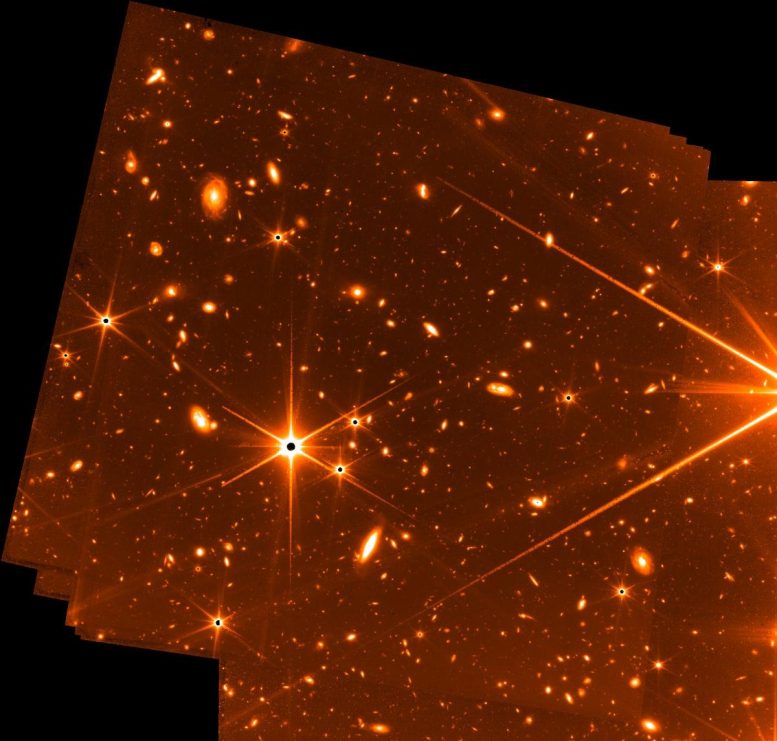
This Fine Guidance Sensor test image was acquired in parallel with NIRCam imaging of the star HD147980 over a period of eight days at the beginning of May 2022. This engineering image represents a total of 32 hours of exposure time at several overlapping pointings of the Guider 2 channel. The observations were not optimized for the detection of faint objects, but nonetheless, the image captures extremely faint objects and is, for now, the deepest image of the infrared sky. The unfiltered wavelength response of the guider, from 0.6 to 5 micrometers, helps provide this extreme sensitivity. The image is monochromatic and is displayed in false color with white-yellow-orange-red representing the progression from brightest to dimmest. The bright star (at 9.3 magnitude) on the right-hand edge is 2MASS 16235798+2826079. There are only a handful of stars in this image – distinguished by their diffraction spikes. The rest of the objects are thousands of faint galaxies, some in the nearby universe, but many, many more in the distant universe. Credit: NASA, CSA, and FGS team.
We are just five days away from the July 12th release of the first full-color images from NASA’s James Webb Space Telescope, but how does the observatory find and lock onto its targets? Webb’s Fine Guidance Sensor (FGS) was designed with this particular question in mind. (The FGS, as well as the Near-Infrared Imager and Slitless Spectrograph (NIRISS), were developed by the Canadian Space Agency.) Recently FGS captured a view of stars and galaxies that provides a tantalizing glimpse at what the JWST’s science instruments will reveal in the coming weeks, months, and years.
Even though the FGS’s primary purpose is to enable accurate science measurements and imaging with precision pointing, it has always been capable of capturing imagery. When it does, the imagery is usually not kept: Given the limited communications bandwidth between L2 and Earth (a distance of 1.5 million kilometers or 930,000 miles), Webb only sends data from up to two science instruments at a time. However, during a week-long stability test in May, it occurred to the team that there was available data transfer bandwidth, so they could keep the imagery that was being captured.
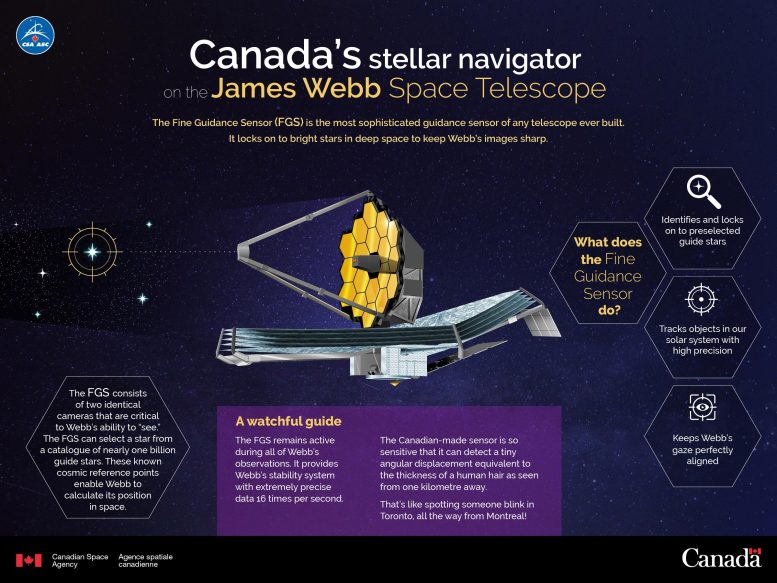
The James Webb Space Telescope will be the most important space observatory of the next decade, serving astronomers from all over the world. One of the two Canadian elements on the James Webb Space Telescope, the FGS is the most sophisticated guidance sensor of any telescope ever built. It locks on to bright stars in deep space to keep Webb’s images sharp. Credit: CSA
The resulting engineering test image (shown at the top of this article) has some rough-around-the-edges qualities to it. It was not optimized to be a science observation; rather, the data was taken to test how well the telescope could stay locked onto a target, but it does hint at the power of the telescope. It carries a few hallmarks of the views Webb has produced during its postlaunch preparations. Bright stars stand out with their six, long, sharply defined diffraction spikes – an effect due to Webb’s six-sided mirror segments. Beyond the stars, galaxies fill nearly the entire background.
According to Webb scientists, the result – using 72 exposures over 32 hours – is among the deepest images of the universe ever taken. When FGS’ aperture is open, it is not using color filters like the other science instruments – meaning it is impossible to study the age of the galaxies in this image with the rigor needed for scientific analysis. But even when capturing unplanned imagery during a test, FGS is capable of producing stunning views of the cosmos.
The Fine Guidance Sensor (FGS) allows Webb to point precisely, so that it can obtain high-quality images. The Near Infrared Imager and Slitless Spectrograph part of the FGS/NIRISS will be used to investigate the following science objectives: first light detection, exoplanet detection and characterization, and exoplanet transit spectroscopy.
FGS/NIRISS has a wavelength range of 0.8 to 5.0 microns, and is a specialized instrument with three main modes, each of which addresses a separate wavelength range. FGS is a “guider,” which helps point the telescope.
“With the Webb telescope achieving better-than-expected image quality, early in commissioning we intentionally defocused the guiders by a small amount to help ensure they met their performance requirements. When this image was taken, I was thrilled to clearly see all the detailed structure in these faint galaxies. Given what we now know is possible with deep broad-band guider images, perhaps such images, taken in parallel with other observations where feasible, could prove scientifically useful in the future,” said Neil Rowlands, program scientist for Webb’s Fine Guidance Sensor, at Honeywell Aerospace.
Since this image was not created with a science result in mind, there are a few features that are quite different than the full-resolution images that will be released on July 12. Those images will include what will be – for a short time at least – the deepest image of the universe ever captured, as NASA Administrator Bill Nelson announced on June 29.
The FGS image is colored using the same reddish color scheme that has been applied to Webb’s other engineering images throughout commissioning. In addition, there was no “dithering” during these exposures. Dithering is when the telescope repositions slightly between each exposure. In addition, the centers of bright stars appear black because they saturate Webb’s detectors, and the pointing of the telescope didn’t change over the exposures to capture the center from different pixels within the camera’s detectors. The overlapping frames of the different exposures can also be seen at the image’s edges and corners.
In this engineering test, the purpose was to lock onto one star and to test how well Webb could control its “roll” – literally, Webb’s ability to roll to one side like an aircraft in flight. That test was performed successfully – in addition to producing an image that sparks the imagination of scientists who will be analyzing Webb’s science data, said Jane Rigby, Webb’s operations scientist at NASA’s Goddard Space Flight Center in Greenbelt, Maryland.
“The faintest blobs in this image are exactly the types of faint galaxies that Webb will study in its first year of science operations,” Rigby said.
While Webb’s four science instruments will ultimately reveal the telescope’s new view of the universe, the Fine Guidance Sensor is the one instrument that will be used in every single Webb observation over the course of the mission’s lifetime. FGS has already played a crucial role in aligning Webb’s optics. Now, during the first real science observations made in June and once science operations begin in mid-July, it will guide each Webb observation to its target and maintain the precision necessary for Webb to produce breakthrough discoveries about stars, exoplanets, galaxies, and even moving targets within our solar system.

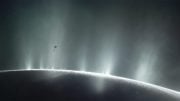

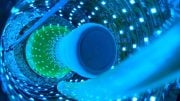



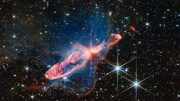
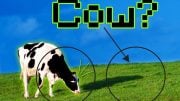
You could spend your whole career just studying this one image. I’m not a scientist and this Pic captures my imagination. Can’t wait for what’s next
We didn’t pay billions of dollars for pictures. Pictures of Mars, pictures of Pluto. Where is the science NASA? Why no science. Still milking the cow?
Still milking the cow? Where is the science? The science is in those long articles with words that have more than three syllables that you don’t like to read, or have not taken the time to understand.
There’s plenty of science going on at NASA, dude, but showing it to you would be a wasted effort as you’re clearly incapable of understanding it.
The images will be painted, the JWST is fake, it is just a toy telescope that can see the solar system planets and that is all. Some guy is up there in the space station taking polaroids and claiming that the JWST did it
Oh and don’t even get me started on the Hubble, that is just some school bus wrapped in aluminum foil flying around up there. The pics it takes are just drawings (or guy with polaroid in space shuttle taking pictures of the planets) and the service missions didn’t really go to the hubble, just went to some asteroids and pretended to work on the hubble
Your not serious are you ,do you know what it would take to get a school bus into space and have you any idea how hard it would be to get a man to an asteroid, it’s easier to build a telescope lol you can’t be serious…. really
Yeah they disguise the bus like a shuttle and put it in between the two rockets like where the shuttle went and they jury-rig three engines on the back of the bus and then it blasts off like the shuttle does lol
My my best wishes and thank you may God bless you
More Please
Fokin flatearthers. Buy a brain
I agree with you.
I have proof that the earth is flat; I put a 4ft level down on the floor in a room and the bubble was exactly in the middle. If the earth was round, the bubble would have been slightly offset.
This here was some that epic southern geo-ometry like kind of intellectual that there stuff…right m’aww!
According to the coevolution theory super massive black hole at the center of galaxy and stars already came to existance since .5 billion years and matured at .6 billion years after the big bang,starting of universe with growth in a uniform scale.So .7 billion years after big bang,super massive black hole at center of the galaxy and stars touch limiting point of growth for existance.But,after .9 billion years after the big bang galaxies started to gain full existance.
Galaxies have a uniform scale of existance for growth and evolution to come into existance from hydrogen gas cloud,as this formed briefly after the big bang.As per Coevolution of super massive black hole at the center of galaxy and stars.
This has been confirmed invisible side of galaxy in time scale for .5 billion years after big bang.Now,example of visible side is obtained in the calibrated scale for galaxy evolved .7 billion years after the big bang in 1st. JWST image by gravitational lensing.Thanks to the JWST scientists for real achivement in the form of nature’s gift.
But JWST observations of more early galaxies than .7 billion years after big bang is possible for .6 billion years own balanced effort and even .5 billion years range after the
big bang with hard work.